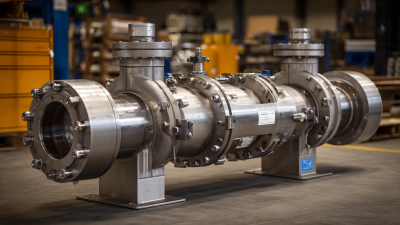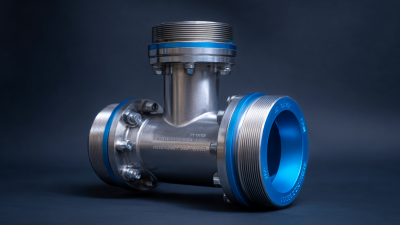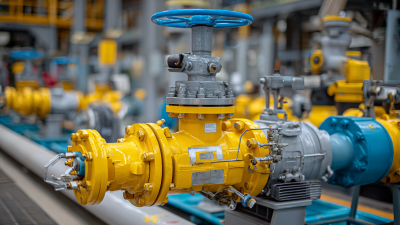How to Optimize Your Pipeline Efficiency with Ball Check Valves: Best Practices and Insights
In today's fast-paced industrial environment, optimizing pipeline efficiency is crucial for businesses striving to reduce operational costs and enhance productivity. According to a report by the Flow Control Industry, inefficient pipeline systems can lead to a staggering 20-40% increase in energy expenditure, highlighting the necessity for innovative solutions.
 One such solution that has gained significant attention is the ball check valve, a vital component designed to prevent backflow and maintain a steady flow rate within pipelines. Utilizing ball check valves not only helps in safeguarding against catastrophic failures but also significantly streamlines processes across various applications in water treatment, oil and gas, and manufacturing industries. By implementing best practices related to the use of ball check valves, organizations can achieve remarkable improvements in efficiency and reliability, ultimately driving down costs and enhancing operational performance. This tutorial explores the essential strategies and insights necessary to effectively integrate ball check valves into your pipeline systems for optimal efficiency.
One such solution that has gained significant attention is the ball check valve, a vital component designed to prevent backflow and maintain a steady flow rate within pipelines. Utilizing ball check valves not only helps in safeguarding against catastrophic failures but also significantly streamlines processes across various applications in water treatment, oil and gas, and manufacturing industries. By implementing best practices related to the use of ball check valves, organizations can achieve remarkable improvements in efficiency and reliability, ultimately driving down costs and enhancing operational performance. This tutorial explores the essential strategies and insights necessary to effectively integrate ball check valves into your pipeline systems for optimal efficiency.
Benefits of Utilizing Ball Check Valves for Pipeline Optimization
Ball check valves are essential components in optimizing pipeline efficiency, offering several advantages that can significantly enhance the performance of fluid systems. According to a report by the American Society of Mechanical Engineers (ASME), improper valve selection can lead to operational inefficiencies costing companies up to 20% of their total pipeline maintenance budget. By utilizing ball check valves, companies can minimize these costs through reduced maintenance needs, as these valves are designed to operate with less wear and tear compared to traditional designs.
One of the key benefits of ball check valves is their ability to prevent backflow, which is critical in maintaining pressure and flow rates in pipelines. A study by the Valve Manufacturers Association (VMA) indicates that systems using ball check valves can achieve a flow efficiency improvement of up to 30%. This efficiency translates into increased productivity and reduced energy consumption, making operations more cost-effective. Moreover, the streamlined design of ball check valves contributes to lower pressure drops in pipelines, which enhances overall system performance and reliability.
Key Performance Metrics for Assessing Valve Efficiency in Pipelines
When assessing the efficiency of ball check valves in pipeline systems, identifying key performance metrics is essential. These metrics include flow rate, pressure drop, and response time. Flow rate is critical, as it indicates how effectively the valve allows liquid or gas to pass through. A consistent flow rate within the specified range ensures that the valve is functioning optimally and contributing to overall pipeline efficiency. Monitoring the pressure drop across the valve is also crucial, as excessive pressure loss can signal wear and tear or obstruction, ultimately affecting system performance.
Another important metric is the response time of the ball check valve. This reflects how quickly the valve reacts to changes in pipeline conditions, such as fluctuations in pressure or flow direction. A swift response time contributes to system safety and integrity, preventing backflow and potential damage. Regular maintenance and performance checks can help maintain these key metrics, ensuring that your pipeline operations remain efficient and reliable. By focusing on these specific parameters, operators can make informed decisions regarding valve selection and maintenance, thereby optimizing overall pipeline performance.

Impact of Ball Check Valves on Reducing Maintenance Costs in Fluid Systems
When it comes to maintaining the efficiency of fluid systems, one of the most significant factors is the reduction of maintenance costs. Ball check valves play a crucial role in this regard. By allowing fluid to flow in only one direction, these valves prevent backflow that can lead to sediment buildup, wear and tear, and consequently, the need for frequent repairs. Their design minimizes turbulence and pressure drops, contributing to a smoother operation which can extend the lifespan of the entire system.
Moreover, the installation of ball check valves can greatly simplify maintenance procedures. Traditional check valves often require more complex installations and regular check-ups to ensure proper functionality. In contrast, ball check valves have fewer moving parts and are less susceptible to clogging. This reliability means that operators can spend less time on inspections and maintenance activities, ultimately resulting in lower overall operational costs. By optimizing the performance of fluid systems with ball check valves, businesses can not only enhance efficiency but also achieve significant savings in maintenance expenditures.
Impact of Ball Check Valves on Reducing Maintenance Costs in Fluid Systems
Case Studies: Success Stories of Improved Pipeline Efficiency
In the realm of pipeline efficiency, ball check valves have proven to be instrumental in enhancing fluid dynamics and reducing downtime. Several case studies highlight how industries have successfully implemented these valves, resulting in noticeable improvements. For instance, a chemical manufacturing plant reported a 30% reduction in product loss during processing after integrating ball check valves. By facilitating a unidirectional flow, these valves prevent backflow, thus safeguarding the system's integrity and maintaining optimal operating conditions.

When looking to optimize pipeline systems with ball check valves, consider these best practices: First, ensure you select the right size of the valve to match your pipeline specifications. This step is crucial for minimizing turbulence and ensuring seamless flow. Secondly, regular maintenance checks are vital; inspect for wear, tear, and buildup, as these factors can lead to inefficiencies over time. Lastly, always consult with valve experts to understand the specific needs of your system and to tailor solutions that align with your operational goals.
Another success story involves a water treatment facility that adopted ball check valves to control effluent flow. The transition not only streamlined their processes but also improved compliance with environmental regulations, showcasing the impact of these components on operational efficiency and sustainability. Embracing ball check valves can lead to remarkable transformations in pipeline management across various industries.
Industry Standards and Innovations in Ball Check Valve Technology
In the ever-evolving world of pipeline management, ball check valves have emerged as a critical component for enhancing system efficiency. Industry standards have established specific performance metrics that ensure these valves function reliably under various conditions. Modern ball check valves are designed to provide optimal backflow prevention while minimizing pressure drop, meeting rigorous standards set by organizations such as the American Society of Mechanical Engineers (ASME) and the American National Standards Institute (ANSI). These standards not only focus on materials and design but also emphasize the importance of regular maintenance and testing to guarantee long-term reliability.
Innovations in ball check valve technology have led to the development of advanced materials and designs that enhance their performance and lifespan. For instance, the incorporation of high-performance polymers has significantly improved the corrosion resistance of these valves, allowing them to perform effectively even in aggressive environments. Furthermore, innovations such as configurable check valves allow for greater customization, catering to specific flow requirements or space constraints. As industries continue to adopt these cutting-edge technologies, understanding and adhering to established standards will be key in optimizing pipeline efficiency and ensuring operational sustainability.
How to Optimize Your Pipeline Efficiency with Ball Check Valves: Best Practices and Insights
| Parameter | Standard Value | Optimal Value | Notes |
|---|---|---|---|
| Flow Rate (GPM) | 500 | 600 | Higher flow reduces back pressure. |
| Pressure Drop (psi) | 20 | 15 | Lower pressure drop increases efficiency. |
| Installation Angle | Vertical | Horizontal | Horizontal installations can improve flow. |
| Maintenance Frequency | 6 months | 12 months | Regular maintenance prolongs valve life. |
| Material | Stainless Steel | High-Alloy Steel | Improved corrosion resistance and durability. |
Related Posts
-

Understanding the Benefits and Applications of Lockable Ball Valves in Industrial Settings
-

Mastering Ball Valve Selection: A Comprehensive Tutorial for Optimal Flow Control in Industrial Applications
-

Unmatched Excellence in PTFE Lined Check Valves: Crafted in China, Delivered Worldwide
-

Understanding Industry Standards for the Best Actuator Valve and How to Choose the Right One
-

Mastering BFV Valves: A Comprehensive Tutorial on Selection, Sizing, and Optimization Techniques
-

5 Essential Tips for Choosing the Right Lined Valves for Your Industrial Needs
